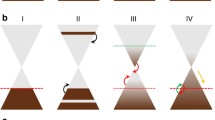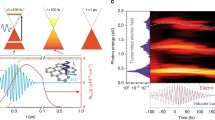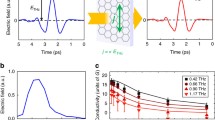Abstract
Energy relaxation of hot carriers in graphene is studied theoretically and experimentally at low temperatures, where the loss rate may differ significantly from that predicted for electron–phonon interactions. We show here that plasmons, important in the relaxation of energetic carriers in bulk semiconductors, can also provide a pathway for energy relaxation in transport experiments in graphene. Reflecting the linear nature of graphene’s bands, we obtain a total loss rate to plasmons that is independent of carrier density. This results in energy relaxation times whose dependence on temperature and density closely matches that reported experimentally.




Similar content being viewed by others
References
Conwell, E.M.: High Field Transport in Semiconductors. Academic Press, New York (1967)
Yamashita, J., Watanabe, M.: On the conductivity of non-polar crystals in the strong electric field, I. Prog. Theor. Phys. 12, 443 (1954)
Reik, H.G., Risken, H.: Distribtuion functions for hot electrons in many-valley semiconductors. Phys. Rev. 124, 777 (1961)
Baraff, G.A.: Distribtuion functions and ionization rates for hot electrons in semiconductors. Phys. Rev. 128, 2507 (1962)
Meric, I., Han, M.Y., Young, A.F., Ozylimaz, B., Kim, P., Shepard, K.L.: Current saturation in zero-bandgap, top-gated graphene field-effect transistors. Nat. Nanotechnol. 3, 654 (2008)
Freitag, M., Steiner, M., Martin, Y., Perebeinos, V., Chen, Z., Tsang, J.C., Avouris, P.: Energy dissipation in graphene field-effect transistors. Nano Lett. 9, 1883 (2009)
Barreiro, A., Lazzeri, M., Moser, J., Mauri, F., Bachtold, A.: Transport properties of graphene in the high-current limit. Phys. Rev. Lett. 103, 076601 (2009)
Plochocka, P., Kossacki, P., Golnik, A., Kazimierczuk, T., Berger, C., de Heer, W.A., Potemski, M.: Slowing hot-carrier relaxationin graphene using a magnetic field. Phys. Rev. B 80, 245415 (2009)
Voutilainen, J., Fay, A., Häkkinen, P., Viljas, J.K., Heikkilä, T.T., Hakonen, P.J.: Energy relaxation in graphene and its measurement with supercurrent. Phys. Rev. B 84, 045419 (2011)
Tan, Z., Ma, L., Liu, G.T., Lu, L., Yang, C.L.: Shubnikov-de Haas oscillations of a single layer graphene under dc current bias. Phys. Rev. B 84, 115429 (2011)
Sun, D., Divin, C., Berger, C., de Heer, W.A., First, P.N., Norris, T.B.: Hot carrier cooling by acoustic phonons in epitaxial graphene by ultrafast pump-probe spectroscopy. Phys. Status Solidi C 8, 1194 (2011)
Majumdar, K., Kallatt, S., Bhat, N.: High field carrier transport in graphene: insights from fast current transient. Appl. Phys. Lett. 101, 123505 (2012)
Baker, A.M.R., Alexander-Webber, J.A., Altebaeumer, Y., Nicholas, R.J.: Energy relaxation for hot Dirac fermions in graphene and breakdown of the quantum Hall effect. Phys. Rev. B 85, 115403 (2012)
Price, A.S., Hornett, S.M., Shytov, A.V., Hendry, E., Horsell, D.W.: Nonlinear resistivity and heat dissipation in monolayer graphene. Phys. Rev. B 85, 161411(R) (2012)
Betz, A.C., Vialla, F., Brunel, D., Voisin, C., Picher, M., Cavanna, A., Madouri, A., Fève, G., Berroir, J.-M., Plaçais, B., Pallechi, E.: Hot electron cooling by acoustic phonons in graphene. Phys. Rev. Lett. 109, 056805 (2012)
Somphonsane, R., Ramamoorthy, H., Bohra, G., Ferry, D.K., Ochiai, Y., Aoki, N., Bird, J.P.: Fast energy relaxation of hot carriers near the dirac point of graphene. Nano Lett. 13, 4305 (2013)
Baker, A.M.R., Alexander-Weber, J.A., Altebaeumer, T., McMullan, S.D., Janssen, T.J.B.M., Tzalenchuk, A., Lara-Avila, S., Kubatkin, S., Yakimova, R., Lin, C.-T., Li, L.-J., Nicholas, R.J.: Energy loss rates of hot Dirac fermions in epitaxial exfoliated, and CVD graphene. Phys. Rev. B 87, 045414 (2013)
Graham, M.W., Shi, S.-F., Ralph, D.C., Park, J., McEuen, P.L.: Photocurrent measurements of supercollision cooling in graphene. Nat. Phys. 9, 103 (2013)
Graham, M.W., Shi, S., Wang, Z., Ralph, D.C., Park, J., McEuen, P.L.: Transient absorption and photocurrent microscopy show that hot electron supercollisions describe the rate-limiting relaxation step in graphene. Nano Lett. 13, 5497 (2013)
Betz, A.C., Jhang, S.H., Pallecchi, E., Ferreira, R., Fève, G., Berroir, J.-M., Plaçais, B.: Supercollision cooling in undoped graphene. Nat. Phys. 9, 109 (2013)
Borzenets, J.V., Coskun, U.C., Mebrahtu, H.T., Bomze, YuV, Smirnov, A.I., Finkelstein, G.: Phonon bottleneck in graphene-based josephson junctions at millikelvin temperatures. Phys. Rev. Lett. 111, 027001 (2013)
Bistritzer, R., MacDonald, A.H.: Electronic cooling in graphene. Phys. Rev. Lett. 102, 206410 (2009)
Kubakaddi, S.: Interaction of massless Dirac electrons with acoustic phonons in graphene at low temperatures. Phys. Rev. B 79, 075417 (2009)
Tse, W.K., Das Sarma, S.: Energy relaxation of hot Dirac fermions in graphene. Phys. Rev. B 81, 235406 (2009)
Viljas, J.K., Heikkilä, T.T.: Electron-phonon heat transfer in monolayer and bilayer graphene. Phys. Rev. B 81, 245404 (2010)
Song, J.C.W., Reizer, M.Y., Levitov, L.S.: Disorder-assisted electron-phonon scattering and cooling pathways in graphene. Phys. Rev. Lett. 109, 106602 (2012)
Virtanen, P.: Energy transport via multphonon processes in graphene. Phys. Rev. B 89, 245409 (2014)
Fischetti, M.V., Kim, J., Nayaranan, S., Ong, Z.-Y., Sachs, C., Ferry, D.K., Aboud, S.J.: Pseudopotential-based studies of electron transport in graphene and graphene nanoribbons. J. Phys. Cond. Matter 25, 473202 (2013)
Eless, V., Yager, T., Spasov, S., Lara-Avila, S., Yakimova, R., Kubatkin, S., Janssen, T.J.M., Tzalenchuk, A., Antonov, V.: Phase coherence and energy relaxation in epitaxial graphene under microwave radiation. Appl. Phys. Lett. 103, 093103 (2013)
Gantmahker, V.F., Levinson, Y.B.: Carrier Scattering in Metals and Semiconductors. North-Holland, Amsterdam (1987). Sec. 6.4
Ferrell, R.A.: Angular dependence of the characteristic energy loss of electrons passing through metal foils. Phys. Rev. 101, 554 (1956)
Klimontovich, Y.L.: Charged particle energy losses due to excitation of plasma oscillations. Sov. Phys. JETP 9, 999 (1959)
Varga, B.B.: Coupling of plasmons to polar phonons in degenerate semiconductors. Phys. Rev. 137, A1896 (1965)
Mooradian, A., Wright, G.B.: Observation of the interaction of plasmons with longitudinal optical phonons in GaAs. Phys. Rev. Lett. 16, 999 (1966)
Kim, M.E., Das, A., Senturia, S.: Electron scattering interadtion with coupled plasmon-polar modes in degeneratre semiconductors. Phys. Rev. B 18, 6890 (1978)
Kasiyan, A.I., Russo, P.I.: Influence of plasma oscillations on the mobility of carriers in polar semiconductors. Sov. Phys. Semicond. 15, 1142 (1982)
Kumekov, S.E., Perel, V.I.: Relaxation of fast electrons in semiocnducotrs at coupled plasmon-phonon oscillations. Sov. Phys. Semicond. 16, 1291 (1982)
Lugli, P., Ferry, D.K.: Investigaation of plasomn-induced losses in quasi-ballistic transport. IEEE Electron Dev. Lett. 4, 25 (1985)
Lugli, P., Ferry, D.K.: Electron-electron interaction and high field transport in Si. Appl. Phys. Lett. 46, 594 (1985)
Lin, M.F., Shung, K.W.K.: Plasmons and optical properties of carbon nanotubes. Phys. Rev. B 50, 17744 (1994)
Wunsch, B., Stauber, T., Sols, F., Guinea, F.: Dynamical polarization of graphene at finite doping. New J. Phys. 8, 318 (2006)
Hwang, E.H., Das Sarma, S.: Dielectric function, screening, and plasmons in two-dimensional graphene. Phys. Rev. B 75, 205418 (2007)
Guiliani, G.F., Quinn, J.J.: Lifetime of a quasiparticle in a two-dimensional electron gas. Phys. Rev. B 26, 4421 (1982)
Altshuler, B.L., Aronov, A.G., Khemelnitskii, D.E.: Effects of electron-electron collisions with small energy transfers on quantum localisation. J. Phys. C 15, 7367 (1982)
Golubev, D.S., Zaikin, A.D.: Quantum decoherence in disordered mesoscopic systems. Phys. Rev. Lett. 81, 1074 (1998)
Tse, W.-K., Hwang, E.H., Das Sarma, S.: Ballistic hot electron transport in graphene. Appl. Phys. Lett. 93, 023128 (2008)
Hwang, E.H., Das Sarma, S.: Quasiparticle spectral function in doped graphene: electron-electron interaction effects in ARPES. Phys. Rev. B 77, 081412 (2008)
Hwang, E.H., Hu, B.Y.-K., Das Sarma, S.: Inelastic carrier lifetime in graphene. Phys. Rev. B 76, 115434 (2007)
Kotov, V.N., Uchoa, B., Pereira, V.M., Guinea, F., Castro-Neto, A.H.: Electron-electron interactions in graphene: current status and perspectives. Rev. Mod. Phys. 84, 1067 (2012)
Hill, A., Mikhailov, S.A., Ziegler, K.: Dielectric function and plasmons in graphene. Europhys. Lett. 87, 27005 (2009)
Lee, P.A., Ramakrishnan, T.V.: Disordered electronic systems. Rev. Mod. Phys. 57, 287 (1985)
Altshuler, B.L., Aronov, A.G.: Electron-Electron interactions in disordered conductors. In: Efros, A.L., Pollak, M. (eds.) Electron-Electron Interactions in Disordered Systems, pp. 1–154. North-Holland, Amsterdam (1985)
Ferry, D.K.: Semiconductors. Macmillan, New York (1991). Sec. 10.3.1
Ferry, D.K., Goodnick, S.M., Bird, J.P.: Transport in Nanostructures, 2nd edn. Cambridge Univ. Press, Cambridge (2009). and references therein
Price, P.J.: Hot electrons in a GaAs heterolayer at low temperatures. J. Appl. Phys. 53, 6863 (1982)
Shishir, R.S., Chen, F., Xia, J., Tao, N.J., Ferry, D.K.: Room temperature carrier transport in graphene. J. Comput. Electron. 8, 43 (2009). and references therein
Ferry, D.K.: Short-range potential scattering and its effect on graphene mobility. J. Comput. Electron. 12, 76 (2013)
Baccarani, C., Jacoboni, C., Mazzone, A.M.: Current transport in narrow-base transistors. Solid State Electron. 20(5), 1–75 (1977)
Castro Neto, A.H., Guinea, F., Peres, N.M.R., Novoselov, K.S., Geim, A.K.: The electronic properties of graphene. Rev. Mod. Phys. 81, 109 (2009)
Author information
Authors and Affiliations
Corresponding author
Appendices
Appendix 1
We note that the emission and absorption of plasmons by hot carriers is not the normal Fermi liquid behavior. If the Fermi sea is completely full at zero Kelvin, then there can be no emission at the Fermi level since the lower energy states are full. We need a spreading of the distribution function at an elevated temperature arising from the hot electron effect, induced by the electric field as shown in Fig. 1. The phase space interaction, illustrating conservation of both energy and momentum can be sketched as in Fig. 5, for both emission and absorption. Here, we show two circles which are the constant energy rings for the states \(E(\mathbf{k})\) and \(E~(\mathbf{k}\pm \mathbf{q})\). These rings are separated by the plasmon energy, which is q dependent. The red ring is the Fermi circle for the initial state, and the blue ring is the Fermi circle for the final state. The initial and final momenta are, of course, connected vectorially by the momentum of the plasmon, so that momentum conservation, as well as energy conservation, is assured in the interaction. Panel (a) represents the situation for plasmon emission, while (b) represents the situation for plasmon absorption.
We begin by writing the energy conservation for the emission process in terms of the magnitudes of the various vectors as
where the plasma frequency has been given in the main text by (3). Here, we have introduced the proper dynamic mass for graphene in the last term. We can now expand the terms in the first equation to get
It is important to note here that the vector properties of Fig. 5a mean that \(\cos \vartheta <0\), or that the angle is in the second or third quadrants. We can now rearrange the terms and square the result to get
or
Thus, we require the term in square brackets to be positive. The solutions are shown in Fig. 6.
The lines for which the delta function is satisfied for the emission of plasmons at two different values of energy of the carriers, as given by (16)
Now, we turn to the absorption process and write the energy conservation in terms of the magnitudes of the various vectors as
We can now expand the terms in the first equation to get
It is important to note here that the vector properties of Fig. 5b mean that \(\cos \vartheta >0\), or that the angle is in the first or fourth quadrants. We can now rearrange the terms and square the result to get
or
Thus, we require the term in square brackets to be positive (Fig. 7).
The lines for which the delta function is satisfied for the absorption of plasmons at two different values of energy of the carriers, as given by (20)
It is clear that there are solutions to the above equations which allow for both emission and absorption of plasmons. In the emission case, the scattering lies in a very small range of angles whose “cone” is 6\(^\circ \)–10\(^\circ \) for the curves shown. This is around the back-scattered direction and has a momentum almost equal to that of the initial state. Hence, this is almost back scattering, but not quite (we note that pure back-scattering in graphene is forbidden in the equilibrium case by chirality). For absorption, there is a very large range of angles for the forward process, but again it occurs for rather large values of the momentum. In both emission and absorption, the scattering involves rather large values of the plasmon energy. There is almost no density dependence in the range of \(10^{11}-10^{12}\,\hbox {cm}^{-2}\), but one would expect the interaction to get stronger nearer to the Dirac point, although the plasmon may be damped strongly in this case by the interband single particle interactions discussed above.
Appendix 2
The integral in (10) may be written as
where
The first term arises from the energy conserving delta function that appears in the integration over the frequency. The second term arises from the fact that the maximum value of q that can occur is approximately the span of the Fermi circle in two dimensions, which translates into a maximum value for u. Generally, this maximum is twice the ratio of the Fermi energy to the thermal energy, and can be quite large. In Fig. 8, we plot both the integrand and the value of the integral as a function of u or \(u_{\mathrm{max}}\), as appropriate. It may be seen that the peak of the argument occurs at a relatively small value of u, due to the dominance of the exponential in the denominator. The integral approaches its limiting value fairly rapidly. The smallest value of the limit occurs for low density and high temperature. In the experiments [16], the lowest value of density is about \(2 \times 10^{11}\,\hbox {cm}^{-2}\) while the highest carrier temperature is about 40 K. These numbers lead to a minimum value of \(u_{max}\) of about 2.4 where the integral has already reached more than half its final value. So, except for low densities at the highest input power per electron, the integral can reasonably be assumed to be the limiting value of approximately 2.4.
The argument and value of the integral (21) as a function of the argument or limit
Appendix 3
The mobility that is measured in the samples as a function of temperature for various densities is shown in Fig. 9. To get to the needed scattering time, one must understand how the various scattering rates are averaged over the scattering angle (See, e.g., [56]). With several scattering mechanisms active in graphene, this is actually rather difficult to unfold. We have considered impurity scattering to be dominant. The actual scattering rate differs from the momentum relaxation time determined from the measured mobility. The actual scattering rate from ionized impurity scattering in graphene can be written as [57]
where \(e^{2}k_F /2\pi \varepsilon _s \) is the screening wave vector and \(2\theta \) is the angle between the incoming and scattered wave vectors—the elastic scattering occurs with \(q = 2k\hbox {cos}( \theta /2)\), and the angle has been doubled in the equation. In the momentum relaxation time, there is an additional factor of \([1-\hbox {cos}(2\theta )]\) in the numerator (See, e.g., [58]). So, the ratio of the momentum relaxation time to the actual scattering time is the ratio of the integrals with, and without, this additional term. This ratio is shown in Fig. 10, with the scattering rates all evaluated at the Fermi surface, appropriate for low temperatures. In graphene, the mobility in suspended graphene is quite high, and can be of the order of several times \(10^{5}\,\hbox {cm}^{2}/\hbox {s}\) [59]. The mobility in the experiments discussed in Ref. [16], and used in the manuscript, are much lower and so are assumed to dominated by impurity scattering. Hence, the ratio in Fig. 6 was used to convert the momentum relaxation time into the actual scattering time used in the computation of the energy loss rate per electron.
Rights and permissions
About this article
Cite this article
Ferry, D.K., Somphonsane, R., Ramamoorthy, H. et al. Energy relaxation of hot carriers in graphene via plasmon interactions. J Comput Electron 15, 144–153 (2016). https://doi.org/10.1007/s10825-015-0764-3
Published:
Issue Date:
DOI: https://doi.org/10.1007/s10825-015-0764-3










